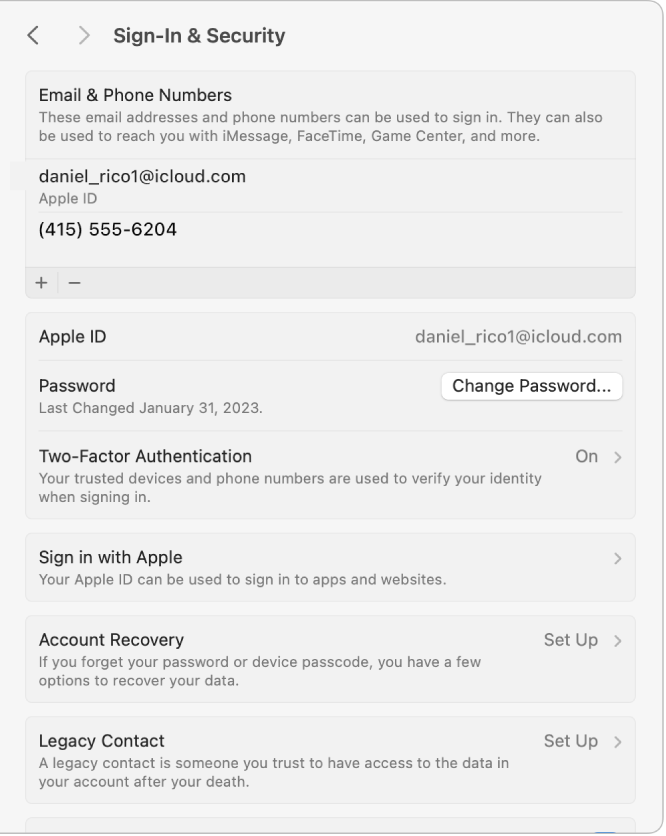
Set up your Apple ID sign-in and security information on Mac
You use Apple ID Sign-In & Security settings to change the emails, phone numbers, and security settings associated with your Apple ID.
On your Mac, choose Apple menu

If you don’t see your name, click “Sign in with your Apple ID,” enter your Apple ID (or another email address or phone number on file), then enter your password. If you don’t have an Apple ID, you can create one.
Click Sign-In & Security, then view or change the following:

Email & Phone Numbers: Add and remove email addresses and phone numbers associated with your Apple ID. Friends and family use these to share notes and documents with you and reach you using iMessage, FaceTime, and more.
Password: Click Change Password to change your Apple ID password. This protects the information associated with your Apple ID, including payment and shipping information, iCloud information, media and purchase information, and more. See Learn how passwords are used.
Two-Factor Authentication: See if two-factor authentication is turned on. (It’s turned on automatically for most Mac computers.)
If it’s on, click Two-Factor Authentication to add or remove trusted phone numbers, set up security keys, or get a verification code.
If it’s off, click “Turn on” to begin using it. After you set up two-factor authentication, you must use it when you sign in to your account—you can’t turn it off.
Sign in with Apple: This option appears only if you’ve used Sign in with Apple to set up an account on an app or website. Click it to see a list of apps and websites that you’ve signed in to using Sign in with Apple. The options provide information about your accounts and the ability to turn off features or stop using Sign in with Apple. See Use Sign in with Apple.
Account Recovery: Choose up to five people you know and trust to become account recovery contacts. If you ever get locked out of your account, a recovery contact is someone who can verify your identity and help you regain access, without being able to access your account and data themselves. You can choose one of your contacts, or if you use Family Sharing, a member of your Family Sharing group. To set up a recovery contact, click Account Recovery, then click the Add button
 . Click Add Recovery Contact, then follow the onscreen instructions. See the Apple Support article Set up an account recovery contact.
. Click Add Recovery Contact, then follow the onscreen instructions. See the Apple Support article Set up an account recovery contact.You can also set up a recovery key to increase the security of your account. Click Account Recovery, click Manage next to Recovery Key, click Turn On, then follow the onscreen instructions.
Legacy Contact: Designate people who will be able to access your Apple account data in the event of your death. Your Legacy Contact can be anyone you choose—they don’t even need an Apple ID or an Apple device. To designate a legacy contact, click Legacy Contact, click the Add button
 , then follow the onscreen instructions. See the Apple Support article How to add a Legacy Contact for your Apple ID.
, then follow the onscreen instructions. See the Apple Support article How to add a Legacy Contact for your Apple ID.Automatic Verification: Turn on to bypass CAPTCHAs in apps and on the web by allowing iCloud to automatically and privately verify your device and account.
For information about changing your Apple ID account information on the Apple ID website, see your Apple ID account page.
For information about changing Apple ID account settings using your iPhone or iPad, see Sign in to your iPhone with Apple ID or Sign in to your iPad with Apple ID.